Anyone getting ready to run the Chicago Marathon needs to read this post! It’s everything I wish I’d known in advance to have the best day possible. Even as a running coach there were lessons to be learned and each race is a little different.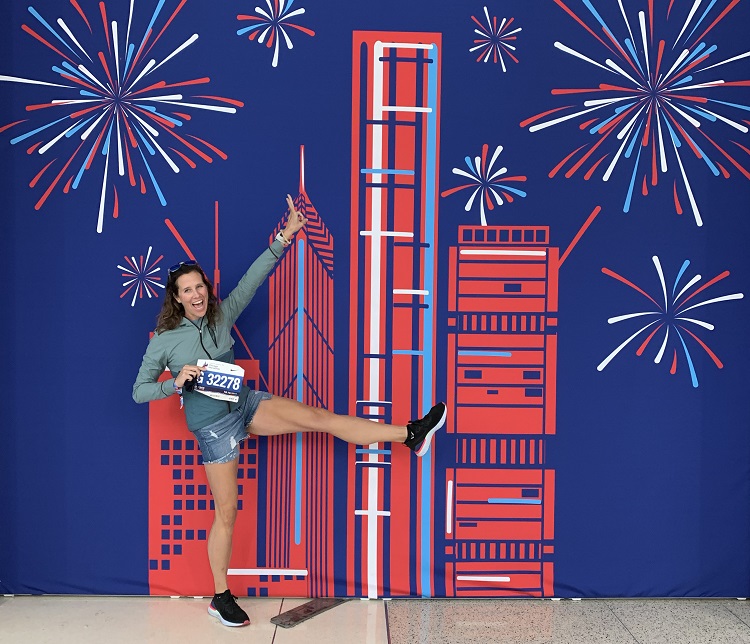
Hopefully these few key pieces to help make life easier! Once you start to realize how long it takes to train for a marathon, I hope you’ve started looking at the right plan!
And then you started thinking…should my training be any different for a flat marathon? Yes.
Is there anything different about the Chicago Marathon Course that I should prepare for? Yes.
I’m so glad you’re thinking ahead and hope these tips will help you have a great race whether it’s your first or you’re out for a Personal Record. Let’s chat about some key Chicago marathon tips!
Chicago Marathon Tips
With any race, I have a few standard recommendations for our athletes:
- Try not to walk around a ton before the race
- Have your pre-race dinner and morning of meal with you or planned out, so you know it’s food you tolerate
- Don’t get sucked in to driving the course 🙂 you should have been training for whatever the elevation looks like and that’s all you can control
- They’ve also explicitly said no selfie sticks this year. Not sure how heavily it will be enforced.
#1 Train for the Flats
One thing that many runners over look is how running a race that’s so flat can actually be harder. You’ll be using the same muscles throughout the race. If you’ve been training on rolling hills, you may find that things start to ache or fatigue.
In Colorado, I made a point of driving to an area where I could do a long run and only get 250 feet of elevation gain.
The entire Chicago marathon elevation gain is only 243 feet!! I get that on a week day 5 miler. So yes, it was really important to train my body to adapt to long flat runs.
#2 Stay Near the Start
The Chicago marathon route is going to take you through downtown which means driving in or even waiting on trains packed with other runners can cause a lot of nerves.
While it’s not cheap to find a hotel downtown, this was a HUGE win. Even my friend who lives in Chicago opted to get a room the night before the race.
- You don’t need to worry about traffic or parking with roads closed
- It was a 7 minute walk to the start area, which basically gave me a chance to warm up
- You can your use your hotel bathroom again more last minute and avoid any potential bad weather a bit longer
Don’t be afraid to ask friends to split a room with you! Then you’ve got someone to share all the nerves with.
#3 Marathon Expo
If they are asking for Vaccination proof again, anticipate a much longer line and go on Saturday if you can. Many of us waited 45 minutes to 1 hour to get in to the expo and then get our bibs. That’s an hour of standing on our feet that wasn’t planned.
Expos are not like they used to be.
More vendors have decided it’s not worth the money and staff for them to attend. So the major sponsor Nike (or whoever) will have a booth. But even Nike wasn’t selling the merchandise there, you could just order to have it shipped.
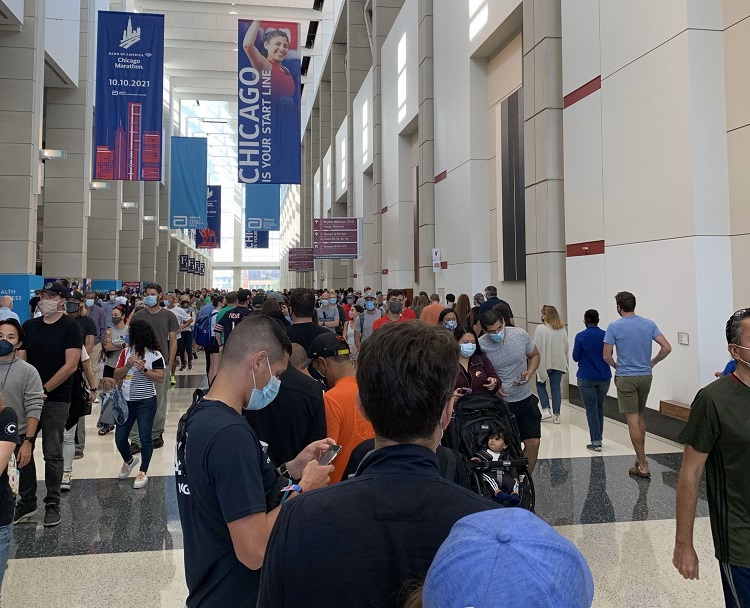
#4 Chicago Start Line Details
A few things you need to know specifically around the Chicago Marathon Starting area in Grant Park.
Hydration
Chicago does NOT allow hydration packs. They DO allow running belts.
Per the rules it specifically says ” Camelbaks® and any type of hydration backpack. For the avoidance of doubt, fuel belts and hand-held water bottles are allowed.”
They have also stated they may ask you to pour out liquids. At our entrance gate they made everyone empty EVERYTHING, except a sealed clear bottle of water.
So if you’re using liquid nutrition like I was, plan to find a water zone inside the start area and mix your nutrition.
If you need recommendations, checkout our tested running handheld bottles and running belts >>
DO NOT skimp on your hydration because of this. Getting low on sodium and overall hydration will impact your race.
Starting Corrals
They have divided corrals up really well based on time and you will have to show your bib to get in to the corral.
Know that in the guide, they will also point you to a recommended security gate. You DO NOT have to go there, but it could be shorter lines, assuming everyone is going where assigned.
Once you get in to your corral, know that it could still be awhile before you cross the start line. Try to contain your nerves and energy. If you’re bouncing around, well again you’re wasting energy.
Security Gates
You’ll go through security to get to where the corrals are. The lines move very quickly, but this is where they are checking for hydration or bringing in bags other than those allowed to be checked.
The guide will tell you which gate it recommends that you go to, but you can enter through any of them.
Gear Check
I’ll be honest, none of us messed with gear check because it felt like adding additional walking to the morning. Are you seeing a theme here, no wasted energy.
That being said, you absolutely can and there will be a color on your bib that tells you which area is designated for your gear. Clear bags only!
Bathroom Lines
Biggest mistake I saw thousands make was to get in line on the outside area of the porta potties.
Walk along in front of the porta potties near your corral and you’ll find many lines, which are much shorter. While none of the ones I visited (yes I used a few) ran of out of Toilet Paper, I’m a big fan of bringing a few tissues with you to the start line.
Sit Down
They tell you to get there two hours early. I found this to be way too much time, especially as I found the shorter bathroom lines. I’d say 90 minutes is plenty.
If you do get there early, sit down. Don’t waste tons of energy standing around.
You’re about to run 26.2 miles and standing is taking energy, and making your legs sore. Sit. Wait. Then get up do some dynamic moves and get in to your corral.

#5 Chicago Marathon Course Strategy
This isn’t a hard course in that it’s largely flat, but it is a course that’s going to require to you to put in the mental work to nail it.
Miles 1-3
Every. single. breakdown. I looked at showed we all started too fast. This not an issue I normally have, BUT here the GPS doesn’t work.
- GPS can’t connect as you go under long bridges
- GPS gets off with the tall buildings
- That means the pace on your watch will swing from 12 min miles to 5 min miles
- That means you need to rely on how you feel, which is hard because you feel good a the start
- So forcibly try to hold yourself back
- Manually hit the lap button at the mile markers to see what you’re running
- This starts to get better after mile 3, but it will happen a few other times as you enter downtown again later
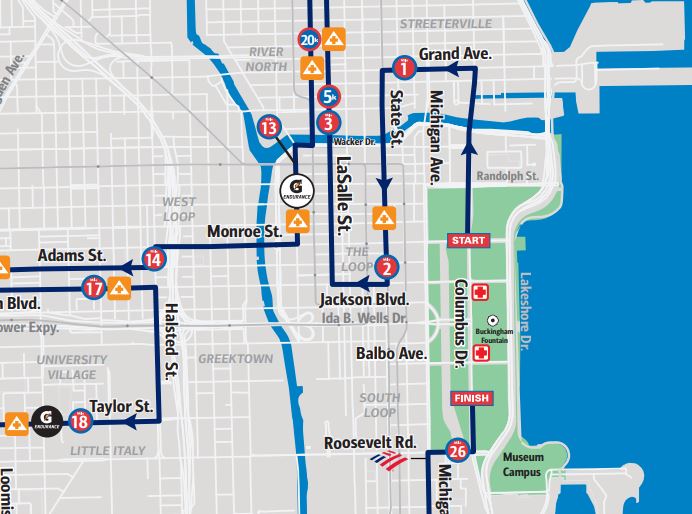
After that, there are a couple other spots where GPS can get messy, but it’s pretty good the remainder of the race.
Limit Your Weaving
No matter where you start in such a crowded course there’s going to be a need to pass people.
- Try not to make any massive weaves, this will add distance to your race
- Just move slightly to the side and keep going
- If you run in to a large pile up, it’s probably a pace group. Try to move to the side to get away from the pacer if you don’t like all the jostling.
How to Run the Bridges
On the bridges look for the carpeted areas.
This feels better than running over the metal grates and I’ll take anything that feels better on the feet. Particularly if it’s a rainy day and you have any fears of slipping.
Stick to the Blue Line
Look for the blue line and try to run as close to it as possible throughout the race. This will help you run the tangents, which means the best chance of only running 26.2.
Final Hill
Everyone talks about the dreaded hill at the end. Living in Colorado I remember finishing and thinking what hill? Honestly if you have done any hill training or run any semi-hilly route on an easy run weekly you’ll be fine.
#6 Chicago Marathon Weather is Unpredictable
Theoretically the time of year means you should get really favorable marathon temps. The ideal race day temps are in the 40’s for fast finishes, but that is rare for Chicago.
A good year is a start of around 55 degrees with decent humidity.
However, Chicago guarantees nothing. There have been multiple years (like mine) where it was 75 degrees at the start line with humidity over 90%. This is not something you can control, but it does mean you need to adapt your race plan.
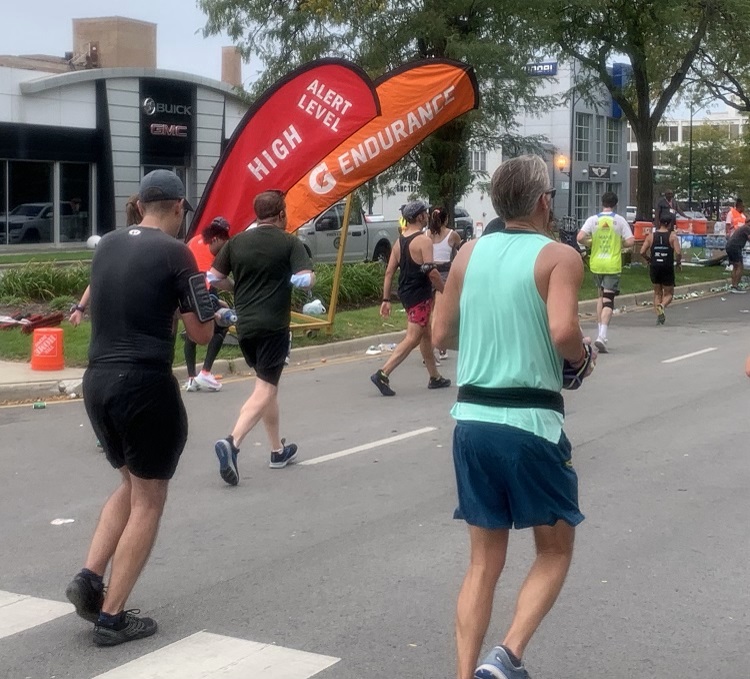
If it’s one of the hot and humid mornings, then you need to know that your HR will climb faster and your effort level will be higher much earlier.
- Start your race a bit more conservatively
- Stay on top of both hydration and electrolytes (I saw many people pull out due to muscle cramps)
- Run through every possible hose, sprinkler or sponge made available
If it’s a rainy day, then checkout my tips for running in the rain. You want to do what you can to keep things dry at the start line. After that it’s just game on!
Chicago Marathon FAQS
A few of your common questions as well!
Do You Have to Qualify for the Chicago Marathon?
No. It’s a lottery system. So you’ll put your name in when the lottery opens (a few weeks after the marathon) and then wait a few months to find out if you were one of the randomly selected who gets to race the next year.
- Those who have run 5 Chicago marathons in the last 10 years have a guaranteed entry
- You can go through a Charity group to get a guaranteed entry
- Fast runners can use a time qualifier to apply during a set period
What is the Chicago Marathon Cut Off?
The Chicago marathon does have a 6:30 cut off time. This is from the time you cross the starting mat, not when the first person crosses the mat.
If you don’t finish in this time, it’s still likely the finish line will be set up, but you will not receive a medal. Additionally, they will begin to open roads and allow traffic back on course. So depending on where you are, some runners have continued on and others are asked to leave the course for safety.
Can You Wear a Hydration Vest to the Chicago marathon?
No. Security will not let you through with a vest. They will allow running belts, but sometimes still ask you to dump out liquids. It’s very hit or miss depending on the person doing security.
How to Run the Chicago Marathon?
Enter the lottery when it opens up and then cross your fingers. Or you can go through a charity spot. This is an amazing way to get in to big races, but does mean you’ll need to spend time fundraising alongside your training.
When is the Chicago Marathon?
It’s usually the first or second Sunday of October.
How Big is the Chicago Marathon?
It’s one of the largest World Major Marathons at 40,000 runners.
The Chicago marathon course is a great one! You just need to go in to it ready to accept what the day may bring!
If you have more questions, let me know! Happy to try and help.
Is the Chicago Marathon Flat?
Yes. Compared to all of the other World Majors this course is very flat with no notable large or steep hills. The elevation gain of the Chicago marathon from start to finish is 243 feet.
Even for Florida runners who train on the flats this won’t be an issue.
Looking for more tips?
Other ways to connect with Amanda
Instagram Daily Fun: RunToTheFinish
Facebook Community Chatter: RunToTheFinish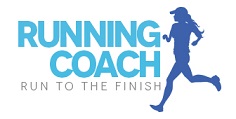
Sign Up to Receive a Weekly Newsletter with Top Running Tips and Laughs

